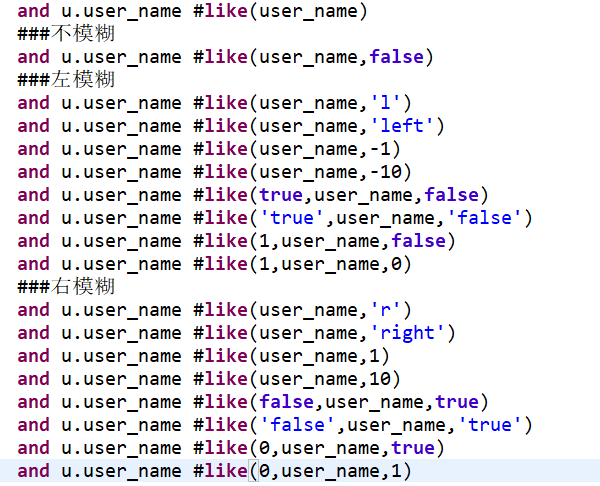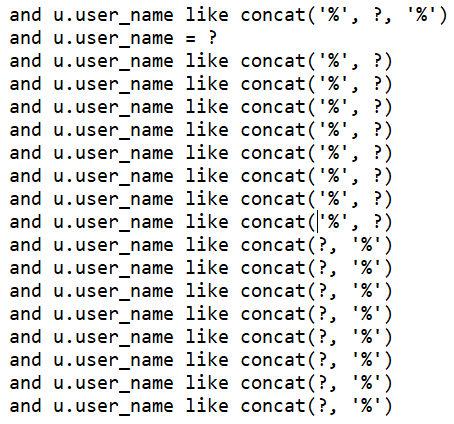不说什么了,直接上代码
public class LikeDirective extends Directive {
private int index = -1;
private int length = 0;
private ExprList exprList;
// 前模糊
private boolean beforeFuzzy = true;
// 后模糊
private boolean afterFuzzy = true;
@Override
public void setExprList(ExprList exprList) {
if (exprList.length() < 1 || exprList.length() > 3) {
throw new ParseException("参数数量错误,必须在1到3之间", location);
}
this.length = exprList.length();
Expr expr = null;
//三个参数的时候取中间的
if (length == 3) {
expr = exprList.getExpr(1);
}else {
expr = exprList.getExpr(0);
}
if (expr instanceof Const && ((Const) expr).isInt()) {
index = ((Const) expr).getInt();
if (index < 0) {
throw new ParseException("The index of para array must greater than -1", location);
}
}
this.exprList = exprList;
}
@Override
public void exec(Env env, Scope scope, Writer writer) {
SqlPara sqlPara = (SqlPara) scope.get("_SQL_PARA_");
getFuzzy(scope);
//左右都不模糊直接 =
if (!beforeFuzzy && !afterFuzzy) {
write(writer, "= ?");
} else {
write(writer, "like concat(");
//左模糊
if (beforeFuzzy) {
write(writer, "'%', ");
}
write(writer, "?");
//右模糊
if (afterFuzzy) {
write(writer, ", '%'");
}
write(writer, ")");
}
// 参数
Expr expr = null;
//三个参数的时候取中间的
if (length == 3) {
expr = exprList.getExpr(1);
}else {
expr = exprList.getExpr(0);
}
if (index == -1) {
sqlPara.addPara(expr.eval(scope));
} else {
Object[] paras = (Object[]) scope.get("_PARA_ARRAY_");
if (paras == null) {
throw new TemplateException("The #para(" + index + ") directive must invoked by getSqlPara(String, Object...) method", location);
}
if (index >= paras.length) {
throw new TemplateException("The index of #para directive is out of bounds: " + index, location);
}
sqlPara.addPara(paras[index]);
}
}
public void getFuzzy(Scope scope) {
//两个参数时
if (length == 2) {
Object object = exprList.getExpr(1).eval(scope);
//boolean 时为开关模糊
if (object instanceof Boolean) {
beforeFuzzy = afterFuzzy = (Boolean) object;
}
//数字时 大于0为右模糊 小于0未左模糊
else if (object instanceof Number) {
beforeFuzzy = ((Number) object).intValue() < 0;
afterFuzzy = ((Number) object).intValue() > 0;
}
//字符串时
else if (object instanceof String) {
String str = ((String) object);
beforeFuzzy = str.equalsIgnoreCase("l") || str.equalsIgnoreCase("left") || str.equals("-1");
afterFuzzy = str.equalsIgnoreCase("r") || str.equalsIgnoreCase("right") || str.equals("1");
}
}
//三个参数时
else if(length == 3) {
{
//第一个参数 为左模糊状态
Object object = exprList.getExpr(0).eval(scope);
if (object instanceof Boolean) {
beforeFuzzy = (Boolean) object;
} else if (object instanceof Number) {
beforeFuzzy = ((Number) object).intValue() == 1;
} else if (object instanceof String) {
String str = ((String) object);
beforeFuzzy = str.equals("1") || str.equalsIgnoreCase("true");
}
}
{
//第三参数 为右模糊状态
Object object = exprList.getExpr(2).eval(scope);
if (object instanceof Boolean) {
afterFuzzy = (Boolean) object;
} else if (object instanceof Number) {
afterFuzzy = ((Number) object).intValue() == 1;
} else if (object instanceof String) {
String str = ((String) object);
afterFuzzy = str.equals("1") || str.equalsIgnoreCase("true");
}
}
}
}
}使用

输出效果



